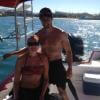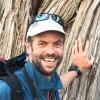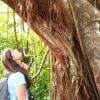How do I get started with LoRa? Connectivity in conservation
1 February 2021 12:00am
Career Paths and Conservation Games with Diogo Veríssimo
 Diogo Veríssimo
Diogo Veríssimo
1 February 2021 12:00am
Open Source Camera Trap
24 January 2021 7:22pm
31 January 2021 10:06pm
Something I'm working on that might work well for you and is super affordable at about $30 per camera.
ESP32-cam (not super high quality photos though) with a motion sensor and it sends the photos to a PI Zero W that can be accesses at any time via wifi. I'm using the TPlink portable but have found that WemosD1 boards and upgrading the firmware to be able to do wifi repeaters works well.
Here's the camera I'm using:
https://starairvision.com/esp32-cam-motion-camera-with-date-and-time/
I'll make a post on here when the full project is built and I've tested the range. The repeaters use something called mesh networking. You can have a number of them in a row to get the camera out into the forest. Or if you have lign of sight you can use a signal booster and or a directional antenna.
31 January 2021 11:39pm
Thanks Ryan would like to hear more about this, the project look awesome what distance are you getting from your wifi router
Audiomoth and Natterjack Monitoring (UK)
23 December 2020 8:16pm
31 January 2021 2:09pm
Hi Sarah, I'm curently working on the sound identification of native and introduced frogs in the UK. I need another season of recordings, and a lot more recordings of Natterjack's, but my aim is to build these into the BTO Acoustic Pipeline hopefully later this year - alongside bats, small mammals, bush-crickets etc to also identify these automatically when they are recorded as 'by-catch.' https://www.bto.org/pipeline.
31 January 2021 3:26pm
Hi Stuart, What sample rate do you think you could go down to? We're interested in a low-power AudioMoth firmware version for this application. Alex
31 January 2021 4:38pm
Hi Alex, I'm not sure what problems there could be with aliasiing and harmonics using a low sample rate, and may depend I guess on how the recordings are processed later on, but I've enclosed a spectrogram of a typical recording below, and can send you some example recordings if useful. Perhaps to use a sample rate of about 10 kHz.., but it's not something that I think about - I always use an excessive sample rate (24 kHz for anurans).

BTO Acoustic Pipeline - is launched!
31 January 2021 1:37pm
Tech Tutors: How do I start a Tech4Wildlife collaboration?
28 January 2021 12:55pm
28 January 2021 6:22pm
One barrier that was discussed in the presentation was the "risk" or uncertainty of a payoff when talking to potential funders. It seems to me that the "risk" factor of collaborations like this, for funders, would be analogous to the investment and payoff when developing a genomics program. Relative to traditional field research, it takes a much greater investment in time, with different expertise, to create a reference genome for a species of interest and then pull SNPs, etc. Nevertheless, funders seem to recognize the potential for genomic research and genomic tools. Do you think that greater openness to “risk” in conservation genomics results from closer intellectual proximity (i.e., molecular biology vs organismal biology), or to conservation genomics being a more mature field (i.e., more examples of success), or to other factors? If intellectual proximity is a key factor, then conservation tech collaborations will continue to face this barrier, but if lack of successful examples are a key factor, then perhaps this barrier will become less of an issue for conservation tech in the future. Thoughts?
30 January 2021 2:26am
Hi. Just watched the Youtube version (I'm in the unable to watch live hemisphere) and wanted to say that was a great talk. I wish it could have gone for another hour. I liked hearing about the issues and concerns from Melanie on the biology/ecology side. Also could totally relate to what Ed was talking about from the tech side about how it's difficult to have long term collaborations since there isn't really a conservation technology career path at the moment.
I think one of the things we're trying to do with courses like Build Your Own Datalogger is to get people involved in wildlife/conservation side more comfortable with the tech. The goal is to hopefully build a shared repository of technical knowledge that people in the wildlife community can contribute to and benefit from.
Akiba
University & Grad School Resources
5 November 2020 11:04pm
12 November 2020 11:01pm
Hi all,
Dropping in with another great program! Many of you have probably heard of this one already: it's the Smithsonian-Mason School of Conservation! They have courses and training options for all education stages, including for high school students who are thinking about following a conservation career path.
The graduate and professional short courses also have a strong conservation tech focus, with training options in GIS, camera trapping, and statistics, specifically. Definitely worth having a look! You can find their courses here.
-Ellie
18 November 2020 8:20pm
Hi again,
WILDLABS member Meredith Palmer shared this great course module for undergrads, based around Snapshot Serengeti camera trap data! This materials are useful for professors who are looking for resources for online biology courses, but the resources may also be useful and interesting for those of you who are exploring conservation tech career options and want to learn more about camera trap studies.
-EllieWe've been hard at work to create distance-learning material based on our #citizenscience #cameratrap projects to teach concepts in #ecology and #conservation. Excited to announce that our 5-week online undergrad module is now available on @CourseSource! https://t.co/5k1dQ8WVJe pic.twitter.com/Huf1MB9ZDG
— Meredith S. Palmer, Ph.D. (@songofdodo) November 18, 2020
29 January 2021 11:17pm
Those of you who are interested in bioacoustics will want to check out this Master's course!
Looking for a master degree in #bioacoustics? Already doing your PhD & wanting to spend 4 months studying #bioacoustics? Look at MoBi, a new Master's course in Bioacoustics, taught in English by over 30 expert tutors from around the world. https://t.co/SgoFRQGpZA
— Nicolas Mathevon (@MathevonNicolas) January 29, 2021
Please RT!
WWF Conservation Technology Series: Drones in Conservation
19 November 2020 9:11am
24 November 2020 8:33am
Hi Julie,
yes authorizations are needed for drones and these are particularly difficult in many countries and are specific to the weight/size of the drone. Look at our report because the difference with a drone from an (untethered) balloon is the the presence of active collision avoidance, manueverability, size/weight and how far it flies (i.e. if it is beyond line of sight it is a different permit).
4 December 2020 12:15pm
This looks like a great resource, thanks!
29 January 2021 7:17pm
Hello Aurelie,
Thank you for sharing this info. I just downloaded the brochure and I am sure I will find it very useful. I have senseFly's eBee Classic, with RGB, multispectral and thermal cameras, and look for cases of using those in nature/biodiversity monitoring/management. I guess the brochure will include some cases. Thanks for sharing.
kind regards, Giorgi (from Georgia)
EarthHz tool
29 January 2021 3:39pm
BYO Data Logger: Live Events - Tell us what you want to discuss!
29 January 2021 1:57pm
Module 3.6: Interrupts
29 January 2021 12:29pm
Ideas on options for offline apps for knowledge sharing
27 October 2020 8:47am
29 January 2021 6:22am
Hi, I'd love to hear your thoughts if you have any other suggestions. Most of the solutions suggested have been a struggle due to the need to download each and every file to each device in order to be accessible offline (we have limited internet) and also in order to have multiple levels of user access.
29 January 2021 10:55am
Ah, if internet is a problem you are somewhat limited. You could leverage a caching solution but it would still require internet at some intervals.
29 January 2021 12:24pm
You never mentioned the sporadic internet access constraint, Nadia; otherwise, I would have mentioned an addtional solution component to alleviate the problem.
For nearly 3 decades, UNIX, Linux and its variants have had a marvelous tool called rsync. It has the ability to automatically replicate file content across networks based on configured rules. While MediaWiki (running on a Linux server) would be the optimal knowledge sharing repository for this initiative, IMO, the client desktops/laptops would just need the appropriate rsync client tools (Cygwin for Windows is available as FOSS) to replicate files automatically from the repository when internet connectivity is available.
Module 3.6: Interrupts
 Akiba
Akiba
29 January 2021 12:00am
Protecting Wildlife with Machine Learning
 Hack the Poacher
Hack the Poacher
29 January 2021 12:00am
Module 3.5: SD Cards and the FAT File System
22 January 2021 5:30pm
27 January 2021 3:05pm
Hi JAL.
Ah I understand now. When we put the libraries in github, we were still debating on what versions we would use. For the RTC library, we initially wanted to use the library available from Arduino Library Manager, but it didn't support the Timer feature and datetime function (it just supported date and time separately). We ended up using a fork of the RTC library with the additional features.
Also there are so many different versions of sdFat and as you saw, one version is incompatible with another. We were using v1.01 at that time which we've field tested and worked well. However after a lot of thought, we finally decided to use the last version of Release 1 which is v1.1.4 .Unfortunately the github libraries didn't get updated. Actually we didn't think anyone would use them and would install the libraries as per the videos. The Github libraries were intended for archival purposes. I'm glad you caught the version mismatch though.
It's actually a good example of one of the painful parts of embedded programming. Getting the right combination of library versions, application code, and hardware so they are all communicating happily together and doing what you want can be quite challenging and frustrating. That's why when we discussed with Steph and Ellie, we liked the idea of doing a deep course, but also wanted to make sure there were a lot of avenues of support. Otherwise, there are so many hidden walls to run into.
Also the github libs have been updated, but I'm glad you got it all to work anyways.
Akiba
28 January 2021 6:37am
Too many things to consider! :-)
This is one of the reasons why I try to work with VsCode, that this IDE allows to save each project with its library versions
But I still have other problems that I do not understand ..., we will continue to insist
The great advantage of this course is your professional support, without it we would be lost!
Best regards !
28 January 2021 7:20am
Ha ha ha. We'll look into PlatformIO perhaps in the future, once we have a break with the courses. In the meantime, there's a lot of other hardware, sensors, and communications to play with still :)
Akiba
SCGIS New Year's Happy Hour Meetup
27 January 2021 10:12am
BYO Datalogger Github Repository
17 December 2020 1:42am
26 January 2021 6:19pm
Hi Akiba,
I am using VsCode and I see that your board is not included in the list of available
What similar board do you think I could use? Do you foresee that your plate will be included in the near future?
Cheers !
26 January 2021 11:35pm
Hi JAL.
I think everyone should use the editor they feel comfortable with, but our courses will assume using the default Arduino IDE. There is a setting where you can use the Arduino IDE just to compile and use an external editor. I recommend possibly using this mode so you can use the included board files we've prepared. We stray a bit outside the standard Arduino ecosystem since we are designing boards specifically for field deployment. We are actually using larger chips with more RAM so our board files are different than the standard included ones.
Akiba
27 January 2021 9:18am
It is true Akiba, I did not remember this option, that the Arduino IDE allows us to work with an external editor
I will also try to send a message to the Platformio managers to include your board in that environment
Thanks !
New Paper: Empowering Rangers Through Technology and Innovation
 Drew Cronin
Drew Cronin
27 January 2021 12:00am
Webinar: How can data empower communities in marine management?
26 January 2021 12:00am
Online thermal imaging courses from the Bat Conservation Trust
26 January 2021 12:00am
Event: Role of GIS in Ocean Conservation
 esri
esri
26 January 2021 12:00am
Eurasian Otter Workshop to highlight Conservation Planning, Threats, and Research Advances for Monitoring Otter Populations
25 January 2021 5:09pm
Seeking mobile app developer
21 November 2020 8:47pm
4 December 2020 12:29pm
Hi Sue
Did you manage to get in touch with AI DigitalWorld - they are developing a lot of conservation apps.
contact: [email protected]
8 December 2020 9:52am
Hi Sue
We focus on building citizen science and conservation apps and might be able to help you. If you still require to make the changes to your app then please PM me or email [email protected]
Here ir our site: https://flumens.io
25 January 2021 9:44am
Dear Sue
I hope your are good.
We are a software company specilized in biodiversity informatics.
We could have a chat.
Cheers
How do I launch machine learning projects using MLOps?
25 January 2021 12:00am
Module 3.2: Temperature and Humidity Settings
21 January 2021 11:43am
24 January 2021 4:46am
An observation I made when first experimenting with DHT22 modules with a Raspberry Pi years ago that still seems true with Arduino and DHT11 sensors. The first reading of the temperature and humidity always seems to be inaccurate for some reason, so my habit was to always read and throw away the first command as part of the device setup.
e.g.
28.10,49.00 <-- inaccurate
29.60,46.00
29.60,46.00
29.60,46.00
29.70,46.00
29.70,46.00
John
Module 3.5: SD Cards and the FAT File System
 Akiba
Akiba
22 January 2021 12:00am
Opportunity: Mobile (Expo/React) Engineer
21 January 2021 2:55am
Module 3.4: Real Time Clock
 Akiba
Akiba
21 January 2021 12:00am
Course Directory
21 January 2021 12:00am
Opportunity: 2021 Ebbe Nielsen Challenge seeks open-data innovations for biodiversity
20 January 2021 12:00am


















25 January 2021 4:41am
Akiba I have used ubiquiti loco m5 to broadcast internet with great success when I was setting up internet for a park for a 10k run I was able to get atleast a mile with no issues with internet
not discorcuaged just looking to piggy back off of a local wifi and be able to connect to a diy camera trap and be able to either do live video feed or capture a pic and then with a program I create send it to email or txt message
the place I am looking at I can get almost a mile in distance but the problem is the power it would have to be some kind of solar power don't want to have to change batteries ever other day